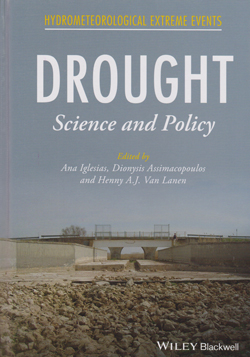
The book has three sections that deal, respectively, with “understanding drought as a natural hazard” (4 papers), “vulnerability, risk and policy” (4), and “drought management experiences and links to stakeholders” (5). All papers include numerous monochrome figures and around 40 of these are reproduced in a separate colour section. This is necessary but irritating. The monochrome figures, while clearly printed, are often inadequate, and concentration is lost while flicking back and forth to the colour section. Sadly, too, the opportunity to use the few blank pages—currently at the end—to enlarge some of the more complex figures, was missed.
Understanding drought begins with a paper full of the abbreviation soup that seems to be common to those involved in climate-change studies. Subsequent papers in the section are based more heavily than the first on actual records of drought over the centuries and, because of that, feel more genuine. Sixteenth century reports of and comments on drought might not be as precise, in modern terms, as could be wished, but the information in them is valuable and the droughts were obviously very real.
The papers on vulnerability, risk and policy are generally interesting, and include one about drought insurance. It helps that the set deals with real-world actions for real-world problems and that the principal assumptions underlying them are made explicit. (In fairness, there is one clear statement in the first section that potential evapotranspiration, PET, which is widely used in drought modelling, is likely to yield unrealistic and conservative results; it is equally true that finding a potentially better option is extremely difficult.)
The final section comprises case studies from Europe, mostly from the Mediterranean region. The experience gained over the last several decades is set out, in each case, along with a resume of the lessons learnt and the resulting changes made. More value might have been added had the further lessons learnt from the most recent droughts been reported. Many issues relating to drought management and stakeholder links might seem intuitive, but all are worth appraising and discussing. The wisdom, for instance, of including stakeholders in both planning for drought and its subsequent management stands to reason. Stakeholders are, literally, at the receiving end, and are likely—individually and as a group—to be more aware more quickly of problems and difficulties as they arise during drought than even the best of managers.
Reviewed by Jeremy Joseph
DROUGHT: SCIENCE AND POLICY, by A. Iglesias, D. Assimacopoulos & H.A.J. Van Lanen (eds) 2019. Published by: Wiley Blackwell, Chichester, UK. ISBN: 978-1-119-01720-2 (hbk) 257 pp.
List Price: £100.00
W: www.wiley.com/wiley-blackwell